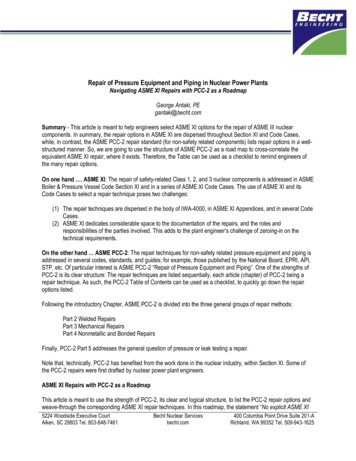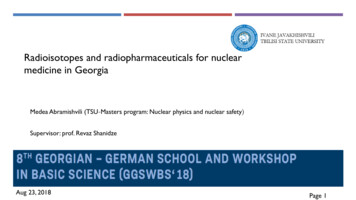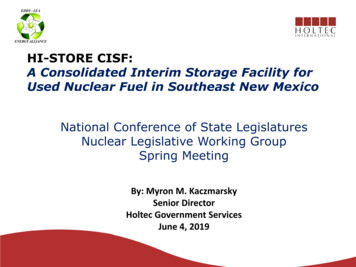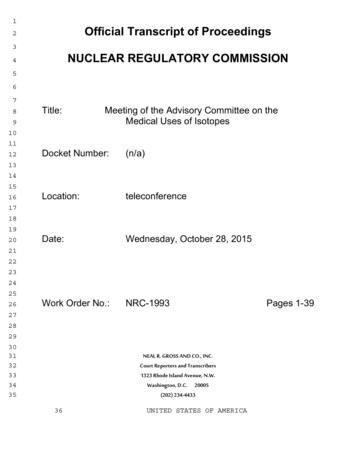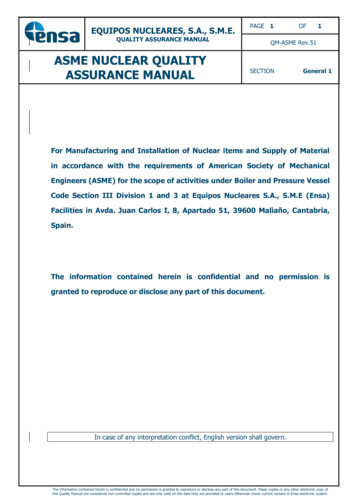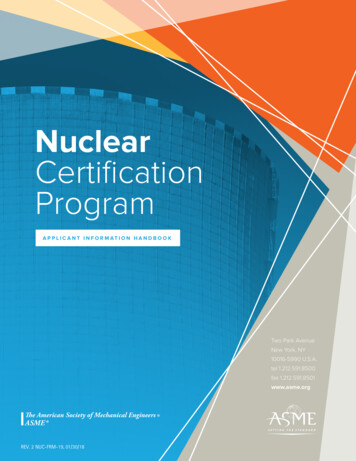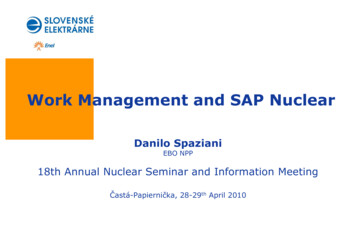
Transcription
Work Management and SAP NuclearDanilo SpazianiEBO NPP18th Annual Nuclear Seminar and Information MeetingČastá-Papiernička, 28-29th April 2010
Agenda1. SAP Nuclear Project2. Project implementation3. Work Management Process: on-line and outage maintenance in SE4. The IPSEC steps: corrective and recurring maintenance5. Conclusions2
Agenda1. SAP Nuclear Project2. Project implementation3. Work Management Process: on-line and outage maintenance in SE4. The IPSEC steps: corrective and recurring maintenance5. Conclusions3
SAP Nuclear Project: Need for ChangeThe long term goal for Sloveske Elektrarne Nuclear is to achieve Top DecilePerformance in Safety, Reliability, Production, and Efficiency and become theWorld’s Premier Operator Of VVER TechnologyAn international benchmarking effort to identify Nuclear Industry Best Practiceresulted in recognition of significant gaps in the following programs: Work Management Equipment Reliability Corrective Action Operating Experience Self Assessment& Benchmarking Human Performance Improvement Current Software (ARSOZ) not supporting Best Practice ProgramsSE needed to establish a model thatspecified appropriate safety andoperational standards includingmanagement, quality assurance,practices and behaviors4
SAP Nuclear Project: SNPMStandard Nuclear Performance ModelElectricity ProductionThe SAP Nuclear Project is theImplementation Phase of a 3-yearsMAJOR Process and OrganizationalRedesign of the Slovenské ElektrárneNuclear OrganizationOperate Plant(INPO)CORE PROCESSESINPO 01-002 Conduct of OperationsManage Configuration(CMBG)Work Management(INPO)Equipment Reliability(INPO)(ANSI/NIRMA CM 1.0-2000)(AP-928)(AP-913Materials and Services(NEI)(AP-908)ENABLING PROCESSESManagementProcesses andSupport 921)Nuclear Fuel(NEI)5
SAP Nuclear Project: BenefitSE Model redesign resulted in new Programs based on Nuclear Industry Best Practicein the following areas: Work Management – INPO AP 928Equipment Reliability – INPO AP 913 (project ongoing)Corrective Action – WEC functionality based on North American Best PracticeOperating ExperienceSelf Assessment&BenchmarkingHuman Performance ImprovementSAP Software System configured and customized to support Nuclear IndustryBest Practice ProgramsImplementation of the SAP Nuclear Project will act as anaccelerant to process, organizational, and behavioralchange leading to significant gains in safety, efficiency,plant performance, and organizational behavior6
Agenda1. SAP Nuclear Project2. Project implementation3. Work Management Process: on-line and outage maintenance in SE4. The IPSEC steps: corrective and recurring maintenance5. Conclusion7
SAP Nuclear – Project Objectives and StrategyImprove EBO and EMO safety and operational performanceBuild up SAP Nuclear Competence CentreRadiation and Radioactive WasteManagement Processes.ARSOZ is considered as processstandard for new implementation.Work Management, EquipmentReliability, and ContinuousImprovement Processes.INPO Guidelines are standardAP-928 (Work Management ProcessDescription)AP-913 (Equipment Reliability ProcessDescription)Strategy:Replace ARSOZ by SAP functionality.No Major Process Changes.Small changes will be made to adapt to EH&S andto align facilities on single processesCorrective Action Process - based onNuclear Industry best practices as keyinputs in process designsStrategy:New processes, new organization structure,and new software system.New Integrated systemSAP Nuclear Competence Centre8
SAP Nuclear Project – SE Approach20087 – 9/08EAMTemplate10 – 12/081 – 3/084 – 6/097 – 9/0910 – 12/091 – 3/104 – 6/10EAM ainingof TrainersDevelopmentof RICEFWTender2010Migration 1TrainingEnd Users (200)4 – 6/082009Full productionEMOLimited Production(Planning 2010)EMO/EBOARSOZ – running200-300 End UsersFull productionEBOTraining of end Users(cca. 2800)Migration 23Change ManagementSup. 1Preliminary Go-Live:Sup. 2Go-Live:9Sup. 3
Agenda1. SAP Nuclear Project2. Project implementation3. Work Management Process: on-line and outage maintenance in SE4. The IPSEC steps: corrective and recurring maintenance5. Conclusion10
Work Management in SEAs defined in the INPO AP-928 the Work Management process is used to Identify,Plan, Schedule, Execute, and Close work in a manner that helps ensure high levels ofsafe and reliable plant operation.The process encompasses the following steps:Work IdentificationPlanned Maintenance – Preventative and SurveillanceOn-lineCorrective MaintenanceModification Activities - InvestmentWork PlanningTechnician InstructionsParts, Tools, Blocking, R-Orders, etc.Work SchedulingIPSECDaily, Weekly, quarterly, cycle online schedulesOutage schedulesLong Term SchedulesWork ExecutionWork CloseOutage11
Work Management: Online ActivitiesWork management is the process by which maintenance, modifications,surveillances testing, engineering support, and any work activities that requireplant coordination or schedule integration are implementedProcesses are simple, efficient, incorporate human factors considerations,and ensure effective performance during all phases of plant operationPlanning and scheduling are applied to activities that impact plant operation orrequire detailed work instructions.The duration of the scheduled work activities are reviewed against technicalspecifications and Probabilistic Risk Assessment (PRA). Work is scheduled tooptimize safety system availability and to ensure maintenance can be performedwithin allowed regulatory or administrative time limits13 Weeks Cycle12
E-6E-5Scope CoolingE-4Cycle ManagerE-3E-2Schedule CoolingE-1Work ManagerPlanningEngineeringParts - Materials – External ResourcesSchedulingOperation - PRAOperation - ClearanceWork Groups13E-0Review - FeedbacksE-7Work ExecutionE-8Work Package ReadyE-9Schedule FreezingE-10Schedule E-4E-11Scope FreezeE-12Schedule E-10E-28Scope E-12Scope E-28Post WorkWeek CritiqueMeetingPlan of the DayMeetingWork WeekTurnoverTechnical RigorReviewScheduleFreeze MeetingCycle Mg /Work Week MgTurnoverScope tingRight WorkMeetingLong aheadscope meetingWork Management: On-line 13 Week CycleE 1
Work Management: Refueling OutagesThe Outage Management process defines a structured approach for thepreparation, the execution and the assessment of refuelling outages byfollowing the Work Management principles through the IPSEC stepsimplementation over a period of 21 monthsM-19Identifylong leadmaterialM-18M-11M-10Identify pre- ng forWosIdentification PhaseSet outagegolasM-5M-2WCDpreparationM-1M-0M ution EvaluationphasephasePreparation PhaseIssueScheduleRev. AIssueScheduleRev. BIssueScheduleRev. 0PerformALARAevaluationIssueScheduleRev. 1Each phase is characterized by set of predefined milestonesaccurately scheduled in order to optimize the wholeOutage Management process14WorkscheduletrackingFeedback &lessonslearned
Agenda1. SAP Nuclear Project2. Project implementation3. Work Management Process: on-line and outage maintenance in SE4. The IPSEC steps: corrective and recurring maintenance5. Conclusions15
The IPSEC Steps: Why SAPWhy SAP?SAP advantages: For every management level:- flexible approach to important information on time- data reliability- approach to the same information for every user (limited only by position)- easier decision process For every organization element:- improvement of the management for operations and transactions- easier data processing and distribution- easy maintenance- used all over the nuclear industry16
The IPSEC Steps: Why SAPSDModules MPMHREH&SISWFIMPSAMCOFIPSSales and DistributionMaterials ManagementProduction Planning and ControlQuality ManagementPlant MaintenanceHuman ResourcesEnvironmental Health and SafetyIndustrial SolutionsWork flowInvestment managementAsset ManagementControllingFinancialProject systemEH&SImplementedModulesin SE, a. s.
The IPSEC steps: Corrective MaintenanceSAP / WEBMaintenancework isIdentifiedMaintenancenotification iscreated in SAPSAPNotification isreviewed andconverted into awork orderWork is Planned and Scheduledand the work order is releasedSAPEndAccounting settles thework order and businessclose.Work order is “Technically Work progress work andClosed” by the Planner status(TECO)Maintenancework is assigned andExecuted18
The IPSEC steps: Recurring MaintenanceSAPCreate/ Update Task List/Maint.PlanIdentifychanges tothe PlanWork order is autogenerated(Identified) in SAPfrom MaintenanceplansWork is Planned and Scheduledand the work order is releasedSAPEndAccounting settles thework order and businessclose.Work order is “Technically Work progress work andClosed” by the Planner status(TECO)Maintenancework is assigned andExecuted19
The IPSEC steps: reate Notif.Plan-Object-When-What steps-Resources-Internal -When-What steps-Avail. Res.-Avail. Eqpmt-CapacityClose-Shop papers-Use resources-Parts-Materials-Tools-Purchasing-Work complete-Time recorded-What was done-Labor used-Parts used-Materials used-Return toolsSchedule WOPrint Work OrderAssign WOPerform WorkCreate WORelease WOContinuousImprovementExecuteComplete WOComplete Notif.Analyze-Usage history-Performance-KPIsAP-91320
The IPSEC steps: Identification1. Initial problem discoveryOperator identifies problem during normal rounds / personal identifies issuesCaptures dataTags equipment2. Problem entered in SAP as a NotificationWHAT3. Initial Review – Shift SupervisorOperability review (task generation)Approval4. Work Control Team Review – daily SOC meetingCreate work orderCode work order to online or outageSet priority and preliminary schedule target (5 priorities)5. Work Order CodingAssign WO to main Work Management Cycle (online – outage)Code WO out of Work Management Cycle (FIN team – minor maintenance – recurring activities)21
The IPSEC steps: PlanningAP-928Identify-Object-Symptoms-WhenCreate Notif.Plan-Object-When-What steps-Resources-Internal -When-What steps-Avail. Res.-Avail. Eqpmt-CapacityClose-Shop papers-Use resources-Parts-Materials-Tools-Purchasing-Work complete-Time recorded-What was done-Labor used-Parts used-Materials used-Return toolsSchedule WOPrint Work OrderAssign WOPerform WorkCreate WORelease WOContinuousImprovementExecuteComplete WOComplete Notif.Analyze-Usage history-Performance-KPIsAP-91322
The IPSEC steps: Planning1. Review – check history – equipment data2. Preliminary requirementsCheck for duplicitySafety ClassificationApproach grade3. Define Work ScopeWork Steps / operations relationshipsTimingResourcesSupport and permitsWork Clearance requirement4. Materials/Services5. Documents/Tools6. Costs – Plan/ActualHOW7. Statusing for WOs23
The IPSEC steps: e Notif.Plan-Object-When-What steps-Resources-Internal -When-What steps-Avail. Res.-Avail. Eqpmt-CapacityClose-Shop papers-Use resources-Parts-Materials-Tools-Purchasing-Work complete-Time recorded-What was done-Labor used-Parts used-Materials used-Return toolsSchedule WOPrint Work OrderAssign WOPerform WorkCreate WORelease WOContinuousImprovementExecuteComplete WOComplete Notif.Analyze-Usage history-Performance-KPIsAP-91324
The IPSEC steps: SchedulingThe scheduling is the process necessary to prepare a database containingall the information needed to model the sequence of work tasks required toaccomplish the approved online/outage scope, minimizing the plant riskand optimizing duration, cost and resources mobilizationSystem WindowThe main scheduling technique isbased on “System window”principle where all plannedmaintenance, in service inspectionand testing activities on a piece ofequipment or a train of a systemare planned to be performed duringa pre-defined time periodSystem 1FEG 1WCDFEG 2WCDWO 1WO 2WO 3CDF minimizationWOoperationsWHENFunctionalEquipment GroupWO 4Work ClearanceDocumenttime25
The IPSEC steps: SchedulingSAP / WEBMaintenancework isidentifiedEndMaintenancenotificationis created inSAPSAPNotification isconverted intoa work orderReports run toidentify order for initialcoding (sys cond)Orders codedto online oroutageMaint Plan Maintenance planauto generateordersFinalize and printschedule andSAP WOsSAPRun Interface inreverse and sendoperation databack to SAPScheduler toscheduleoperations andWCD’s in externalsoftwareSAP – PrimaveraRun SAPinterface toexternalsoftwarePerform initialwork centercapacityevaluationsPlanning toperform initialsequencing ofoperations26Work is plannedand the work orderis released
The IPSEC steps: SchedulingOrder data:Order number, typeShort textFunctional LocationMain Work CenterFEGDue dateOverdue dateRevision codeBasic start / end date & timeSystem Status / User statusAdd / drop field ( custom)WCAFEG of WCAWCD numberSAPOperations:Order data:PrimaveraSchedulingProcessSAPWork Order numberRevision CodeWCA number (linked to Work Order)WCD number (linked to Work Order)Operations:Restriction start dateRestriction start timeRestriction end dateRestriction end timeActivity IDOperation #Project IDOperation short textPosition on Critical PathControl keyDurationNumber of personsWork center of operationEarly start / finish date & HoursActual start / finish date and hoursRelationships dataWCD basic data:WCD #WCD basic data:Date & time tags hanging startDate & time tags hanging endDate & time tags removal startDate & time tags removal endPrimavera Project IDPrimavera Activity IDPosition on Critical pathWCD DescriptionWCD Functional LocationSystem Status / User StatusRevision code of the WCDFEG of the WCDInterface - data synchronization27
The IPSEC steps: ExecuteAP-928Identify-Object-Symptoms-WhenCreate Notif.Plan-Object-When-What steps-Resources-Internal -When-What steps-Avail. Res.-Avail. Eqpmt-CapacityClose-Shop papers-Use resources-Parts-Materials-Tools-Purchasing-Work complete-Time recorded-What was done-Labor used-Parts used-Materials used-Return toolsSchedule WOPrint Work OrderAssign WOPerform WorkCreate WORelease WOContinuousImprovementExecuteComplete WOComplete Notif.Analyze-Usage history-Performance-KPIsAP-91328
The IPSEC steps: ExecuteWork Order is ExecutedOperations to hang Work Clearance Tags in the fieldWCA is approvedPermits are approvedOrder is set by Ops to EXEC (Ready to execute)Maintenance sets Order User status to MWIP (in progress)Execute the work into the filedField operations partially and then finally confirmedOutageOutage schedule tracking / adjustmentWork executedSAP - PrimaveraScheduletracking29
The IPSEC steps: CloseAP-928Identify-Object-Symptoms-WhenCreate Notif.Plan-Object-When-What steps-Resources-Internal -When-What steps-Avail. Res.-Avail. Eqpmt-CapacityClose-Shop papers-Use resources-Parts-Materials-Tools-Purchasing-Work complete-Time recorded-What was done-Labor used-Parts used-Materials used-Return toolsSchedule WOPrint Work OrderAssign WOPerform WorkCreate WORelease WOContinuousImprovementExecuteComplete WOComplete Notif.Analyze-Usage history-Performance-KPIsAP-91330
The IPSEC steps: CloseTime sheetEntryWork Order and Notification ClosedWO set WOCO status by MaintenanceWCA is completed by MaintenanceWCD set to untag by Plant OperationsSafety tags removed in the fieldWork OrderCompletionWCD is closedNotification has history updated and finaltrending completedAll open tasks completedWO is set to a TECO system statusNotification auto closesWO tNotificationsTechnicalcompletion31
The IPSEC steps: Work Management KPIsWork Management Process needs a monitoring system that incorporates a systematic review of actualresults and compares these with expectations established by objectives.As shown by Nuclear industry experience SE adopted an effective way to perform work managementmonitoring by using a set of indicators (KPIs) that reflect, in a quantitative manner, the achievementsof the expected results for on-line and outage process.On-lineOutageKPIsKPIs Urgent work/High priority Scope stability On-line executed work Weekly executed work Not terminated work Scope stability from T-6 T-0 Deviations from planned work man-hours WOs operations planned WOs planned WCD prepared WOs added to weekly plan Number of NM notifications Planned outage duration Outage scope Scope stability Outage cost vs. budget Outage total dose vs. dose budget Regulatory Body involvement WOs operations planned WOs planned WCD prepared Materials and services preparedness Outage personnel preparedness Timeliness of critical path Number of Safety events Unplanned work rate Not executed work rate Number of contaminations events Number Human performance error events Evaluated onweekly andmonthly basis viaSAP andinterfacedsoftware
Agenda1. SAP Nuclear Project2. Project implementation3. Work Management Process: on-line and outage maintenance in SE4. The IPSEC steps in SAP: corrective and recurring maintenance5. Conclusions33
Conclusions7 months after the SAP Nuclear Project Go-live it can be stated that: Work Management process is currently implemented at both SE sites (EBO and EMO) New way of managing work preparation and execution for on-line and outage Organizational structure completely redesigned to support process implementation SAP as implemented and customized capable to support the whole Work Managementprocess (including clearance and permits) The usage of Primavera for WOs scheduling safe and reliable also for schedule tracking KPIs used on weekly on monthly bases for process monitoring and improvement Remarkable increase of operational and safety standards Work Optimization Alignment with Nuclear Industry leader organizations Stronger cooperation between SE Facilities and increased capability of internationalbenchmarking SAP Nuclear and Work Management experience as an improvement tool to be exportedinside Enel Group nuclear companies34
Questions?35
Work Management and SAP Nuclear Danilo Spaziani EBO NPP 18th Annual Nuclear Seminar and Information Meeting Častá-Papiernička, 28-29th April 2010. 2 Agenda 1. . Work Groups Work Manager E -28 S c o p e E-2 8 L o n g a h e a s c o p e m e e t n g Scope Cooling Cycle Manager Schedule Cooling





